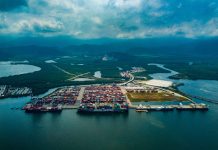
The Lloyd’s Register (LR) Maritime Decarbonisation Hub and the Maersk Mc-Kinney Moller Centre for Zero Carbon Shipping conducted a joint study into ammonia safety onboard ships, which discovered that a variety of mitigation methods, from ship design to crew training and operations, are required to keep toxicity risks to the crew within published tolerable limits.
“Recommendations for Design and Operation of Ammonia-Fuelled Vessels Based on Multi-disciplinary Risk Analysis” is the most complete research of risk mitigation methods in three ammonia-fueled vessels – a container ship, a tanker, and a bulk carrier – to date, according to the two shipping organisations.
The joint study was able to identify vessel design and operational procedures that would decrease ammonia risks to an acceptable level using Quantitative Risk Assessment (QRA) analysis, a strong data-driven tool that allows users to quantify risk in a quantitative and detailed manner.
The QRA makes suggestions for the construction and operation of ammonia-fueled vessels to increase crew safety.
According to the statement, lower storage temperatures were recommended to reduce safety risk, provision for two or more separate spaces containing different groups of equipment that could leak ammonia, monitoring and minimising access to and length of time spent in spaces containing ammonia equipment, ventilation outlets from spaces containing ammonia equipment placed in a safe location, adequately separated from areas accessed by the crew and installation of two or more separate spaces containing different groups of equipment that could leak ammonia.
In addition to the QRA, the second part of this study summarises findings from an investigation of human factors issues that would be influenced by a switch to ammonia fuel.
These include the competence and training required to improve safety on ammonia-fueled vessels, as well as safe work practises and standard procedures that must be implemented through systematic change management programmes, and effective occupational health safeguards, such as personal protective equipment (PPE).





